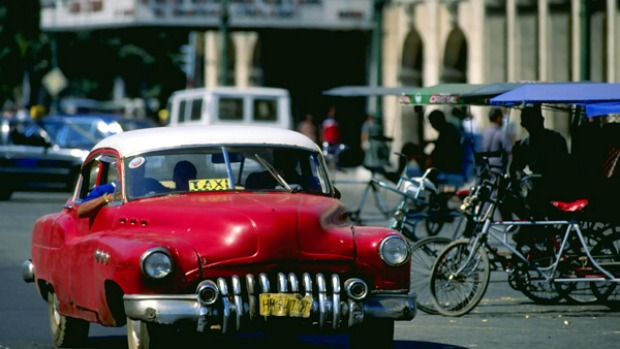
Shaney Hudson has some extraordinarily good fun mixing with ordinary Cubans.
We have just sat down to dinner when a sharp cry echoes up through the atrium. We freeze. More voices answer and the chorus soon becomes a cacophony as yelling comes from the street.
"Mi Dios," our hostess shrieks, running for the door.
"Cristina, what is it, is everything OK?" we ask, jumping to our feet in alarm. A number of possibilities flash through my mind. The building is on fire. Someone is hurt. Civil war? Our hostess whips around as she is halfway through the door, a smile spreading across her face.
"The fridges are coming!" My partner and I look at each other blankly. Fridges? Huh?
And then we remember we're not in Kansas any more. We're in Cuba. You can't just go out and buy a fridge, you have to wait for the Government to give you one. And in Cristina's case, her street's delivery day is today, as part of Fidel Castro's measures to be a more energy-efficient nation.
As the news spreads, a spontaneous party erupts on the street below. Men posture, women chirp and children run amok way past their bedtime. It is an unexpected glimpse into everyday Cuban life and just one of the many advantages of staying with a Cuban family in a Casa Particular.
Casa Particulars are a Cuban version of a bed-and-breakfast and are distinguishable by a blue-and-white sticker on the front door. Operating under licence, ordinary families can rent rooms to foreigners as part of a Government scheme designed to address an accommodation shortage.
Casas have to meet strict standards, which ensure most places are clean, comfortable and safe. Finding a casa is tricky. Although there are thousands in Havana, most are booked out weeks in advance. We spend our first day roaming from casa to casa. In one way it's an enthralling insight. Behind one unassuming door one casa is stacked with 40 birdcages; the next is a bohemian artist's heaven filled with sculptures; another is filled with precious antiques. Eventually, we find a double bedroom with bath and air-conditioning just a few blocks from the main tourist drag of Old Havana.
Life is lived on the streets in Cuba, which means if your room is facing the road, like ours, you're not going to get much sleep. But it's a simple pleasure to sit and watch life go by: babies sit in playpens on the pavement while their mothers gossip; children play baseball on the road; old Chevrolets line the kerb like pieces of historic candy; washing streams across every balcony like garland; and the art deco buildings crumble like sad smiles from the past.
Our room may not be much to write home about but our hosts certainly are. Aurelio and Cristina are empty-nesters with two grown sons. Their genuine kindness, helpfulness and good humour make coming home from a day's sightseeing a pleasure. And running a casa provides them with much-needed funds.
Most Casa Particulars cost from CUC20 to CUC35 ($30-$54) a night and are the most affordable accommodation option in the country. Casa owners are heavily taxed, so most are entrepreneurial and offer a number of services on the side, such as laundry, meals and transfers, to make extra money. Eating in at your casa is often a better option than eating out. On our first night we are served a feast of lobster and crab with black beans, rice, salad, bread and pudding an outstanding meal that is only surpassed a few days later by Aurelio's signature dish of slow-cooked citrus pork with fried plantains.
But the best optional extra we indulge in is salsa lessons with Aurelio's brother, Freddy. We throw open the windows, move the furniture, roll up the rug and the living room becomes our dance floor for the next few hours. The brothers squabble in Spanish about the steps and we end up in fits of giggles as they take turns to lead each other. Eventually, Cristina kicks off her thongs and settles the debate.
"Tomorrow, then, you will come to Aurelio's birthday," Cristina declares afterwards. "There will be dancing." A private party in Cuba? It's an invitation too good to refuse.
The next night we climb six flights of stairs to a rooftop terrace where we are inundated with smiling faces and kissing cheeks, paper plates of food and cups of beer. A full moon glitters over the rooftops of Old Havana and the landmark Capital and Bicardi buildings peek over the cityscape at us. Most people we talk to are surprisingly candid in their opinion of their Government. In increasingly animated Spanglish we broach a range of topics, from Fidel Castro to the US, to Australian politics and baseball.
Children tear through the fiesta, old-timers watch contentedly from chairs and dancers aged seven to 70 dance rouletta, a form of salsa-in-the-round. We're pulled into the mix and laugh with them as they twirl us through the steps.
This is ordinary life, these are real people. It's the real Cuba and I love it.
TRIP NOTES
Getting there
Cuba is best reached by flights from Mexico or Panama. Flights to Havana start at $US196 ($275) return from Panama City through Copa Airlines. See copaair.com. Australians require a visa ($85, see embacuba.cubaminrex.cu/australiaing.
Staying there
Casa CristinayAurelio is at 109 Calle Luz, Apartamento 9, Centro Historico, La Havana Vieja, Cuba. Cristina and Aurelio have a small site at geocities.com/sucasacubana. Due to government restrictions on email, bookings are best made by phone on +5378676373. Limited English is spoken. For online bookings, a number of casas, including Christina and Aurelio's, are available through hostelworld.com.